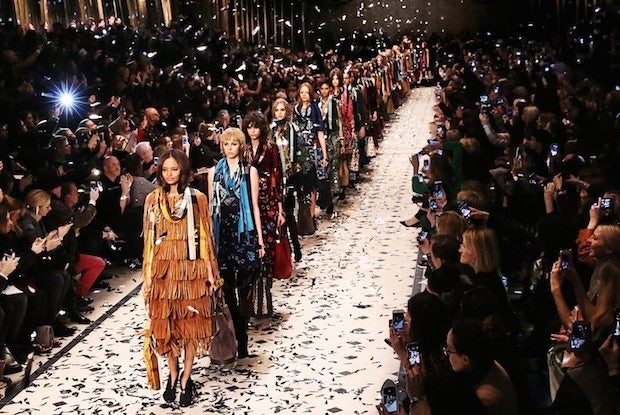
Burberry's Fall/Winter 2015 fashion show. (Courtesy Photo)
After Chanel’s recent dramatic move to lower its China prices to combat China’s gray market, Burberry is the latest brand to consider a similar policy at a time when it's seeing a Hong Kong-driven China sales decline.
Despite strong sales in its traditional markets of the Americas and Europe, this week Burberry reported a sharp drop in sales in Hong Kong, a key market for the iconic British luxury brand. An earnings statement released for the six-month period ending March 31 states that in Hong Kong, the brand saw "a mid single-digit percentage decline in comparable sales in the half," while China and Korea grew by a mid single-digit percentage. The brand saw “further deterioration in Hong Kong,” according to CFO Carol Fairweather in its earnings conference call.
Burberry isn’t unique in recording disappointing sales in the city last year as Occupy Central protests rocked the city, and the pain has gotten worse in 2015 now that anti-mainland demonstrators are specifically targeting Chinese shoppers. In January, Hong Kong reported its worst retail sales since the SARS crisis of 2003.
Burberry’s fortunes in Hong Kong have been driven in no small part in recent years by two mainland Chinese groups: younger middle-class shoppers and gray-market daigou buyers. Although these two groups have been unaffected by China’s anti-corruption campaign, they do care about price—and pricing in Hong Kong is simply not as competitive as it once may have been. In fact, many price-sensitive shoppers have been lured away by the likes of South Korea, which has emerged as a luxury shopping hotspot in recent years. That’s why Chanel’s price drop was actually larger in Hong Kong than mainland China—its signature flap bag was cut by $1,400 in Hong Kong and only $1,300 on the mainland.
Many Chinese tourist-shoppers are attracted to Seoul and Jeju by better prices (particularly for massively popular Korean cosmetic brands) and an overall better shopping environment. With hostile reception from Hong Kong locals, a growing number of mainland Chinese have decided to take their wallets elsewhere.
As it makes efforts to boost flagging sales in the Greater China region and faces a wider China-Europe price difference with a weakening euro, Burberry could take a page from Chanel’s recent playbook and drop prices in the region while increasing them in Europe. Fairweather said this week, “We always maintain our price positioning by market relative to our immediate peers…Following that, as prices move, we would also move prices up or down in the same way.”
For Burberry in particular, price shifts may be unavoidable as Chinese shoppers become more price-savvy. According to Barclays, Burberry’s price differential between Europe and China is among the widest among major luxury brands, and if nothing changes, despite Burberry’s innovative e-commerce and social media efforts in the China market and commitment to Hong Kong, it will be hard to boost domestic sales without a price reduction.